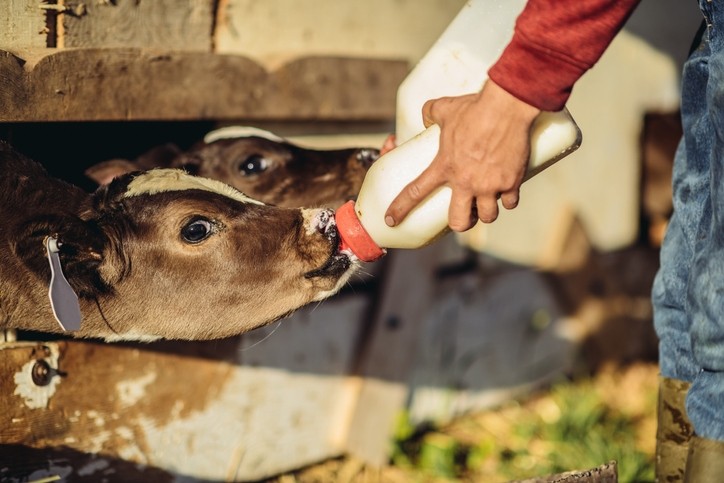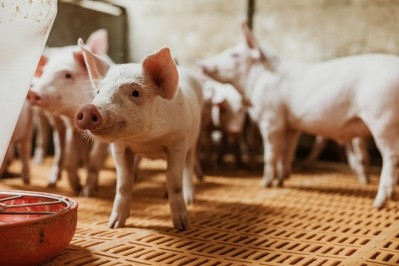Fatty acid insights: Is the stage set for a paradigm shift in calf nutrition?

The results of that research were disclosed at the third LifeStart Symposium last month co-hosted by Trouw Nutrition, the livestock feed business of Nutreco, and the University of Nottingham School of Veterinary Medicine and Science, in Nottingham in England.
Dr Michael Steele, professor at the University of Guelph and Juliette Wilms, PhD candidate, Trouw Nutrition, presented findings from research that compared the health and development of calves fed whole bovine milk powder along with three milk replacers based on high-fat, high-lactose, or high-protein formulations.
They saw that differences in the macronutrient profile and composition of high-protein and high-lactose milk replacers resulted in distinct profiles relevant to metabolism and endocrinal functions compared to calves receiving milk. In contrast, they observed a lack of difference between calves receiving whole milk or the high-fat milk replacer. Additionally, calves fed the high-fat diet in the first week had higher liver weights suggesting the role milkfat plays in organ development, they noted.
Applying the research findings to calf nutrition offers a tool to restore biological references and mimic the natural signals in milk that contribute to healthy herds and more efficient dairy production, they concluded.
This discovery allows milk replacers to be formulated in a way that more closely resembles bovine milk, compared to milk replacers traditionally based on available dairy industry bioproducts, claims Trouw Nutrition.

Javier Martín-Tereso, manager of the ruminant team at Trouw Nutrition R&D unit, believes that the findings set the stage for a paradigm shift in calf nutrition. “If you have an alternative tool that closely mirrors the components in milk, you can be more generous in the supply of nutrients to calves, so they are less hungry, setting them up for better growth.”
We ran a Q&A with Juliette Wilms, to hear more about the discovery.
FeedNavigator: What was the impetus for conducting this research and what were some key data that emerged?
Juliette Wilms: There is extensive evidence in the scientific literature that butyric acid plays an important role in calf health and development, and several studies suggest that caproic acid may play a role in calf development as well. The research team at Trouw Nutrition has been investigating the role of nutrients and bioactives found in whole bovine milk and looking at the effect on calf development, health, and growth. Using bovine milk as our biological reference, we wanted to investigate what the benefits to the calf would be if we restored the missing short and medium-chain fatty acids in milk replacer to the levels found in milk fat.
Our research demonstrates that restoring these fatty acids in milk replacer results in improved development of the small intestine and improved development of the rumen. Milk replacer (and milk) is shunted past the rumen by the esophageal grove during normal feeding behavior. The improvement in the rumen suggests that these fatty acids act as a biological signal that guides the calf’s tissue and organ development. In addition, we saw a change in insulin response with an improvement in insulin sensitivity.
The improved development of the calf’s digestive system resulted in increased calf starter intake, reduced incidence of severe calf scours, and increased weight gain that persisted past weaning.
FEN: What were some unexpected insights?
JW: Based on the existing body of research on the role of butyric acid and caproic acid on gut health and development, we expected to see an improvement in intestinal development when we added these short-chain fatty acids back into the milk replacer. We did not anticipate the magnitude of the responses observed, or that we would also see an improvement in rumen development.
The insight is that milk plays a communication role beyond its great nutritional value. It brings signals from the mother that guide the calf’s development. Expanding our understanding of this signaling role provided a blueprint for replicating this activity, which we think will shift how calves are fed in the future, benefitting not only their performance but also their health.
Another surprise was the magnitude of the benefits to the development, health, and growth of the calf that was derived by the composition of fat used in milk replacer. The composition of fatty acids within the fat demonstrated even greater responses than the fat content of the milk replacer.
The growth performance that we observed by restoring these short and medium-chain fatty acids does not seem to be driven by pushing the accelerator; it is more like removing the brake.
FEN: How will dairy farmers benefit from this discovery?
JW: Farmers who want to maximize the lifelong performance of their calves throughout maturity will be able to use this discovery to maximize growth and development in a natural way. The result would be an optimal age at first calving. Our LifeStart research demonstrates that this will increase longevity and improve milk productivity. That translates into a more profitable cow and a lower environmental footprint of the milk she will produce.
FEN: What are future areas of research you plan to explore?
JW: We will continue to look more deeply into fatty acids, as research suggests there is more potential for improved nutrition in this area. We will also be looking more at the protein fraction in milk replacers, especially the relationship between casein and whey, which goes beyond amino acid balancing.











